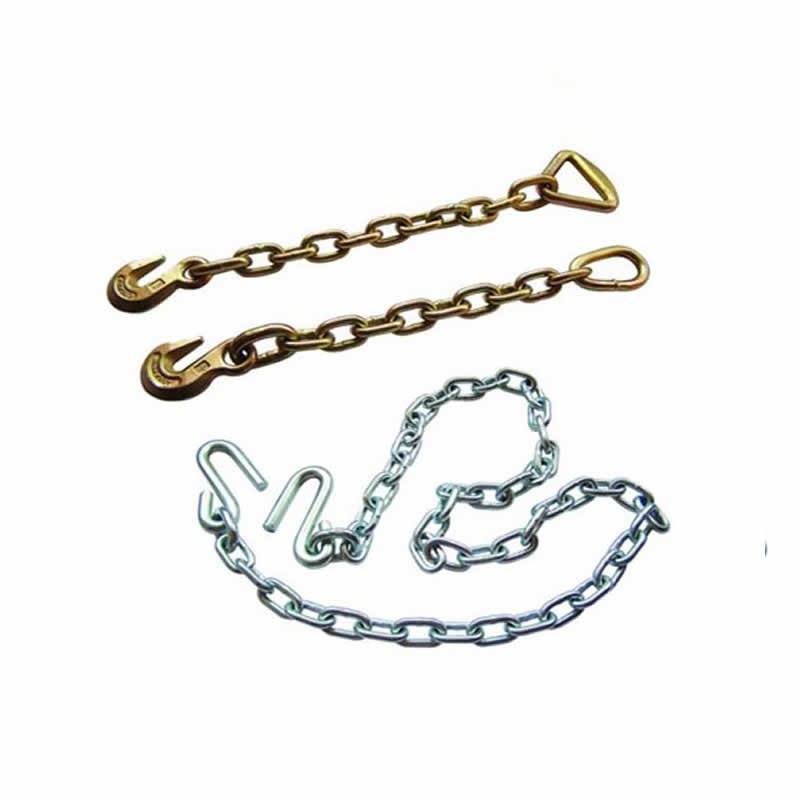Lashing chain

PRODUCT OVERVIEW
Our top-quality lashing chains are built for secure cargo transportation and heavy-duty load securing. Our reliable lashing chains provide exceptional strength and durability, ensuring peace of mind during transportation.
- Material: High-quality alloy steel
- Surface treatment : Self-color, Polishing, blackened, painted, plastic coating, hot-dip galvanize,electro-galvanized, etc
- Manufacture standard: ISO, EN,DIN, BS, JIS, ASTM
- Quality Grade: G70, G80, G100
- Safety factor: min 4
- Product marking: "LINK" or required by client
Specification

|
NO. |
Size DiaX Inside Length X Inside Width mm | Breaking Load min. T | Weight kg/m |
| 2 | 7 × 45 × 10 | 6. 2 | 0. 83 |
| 3 | 9 × 53 × 15 | 10. 2 | 1.40 |
| 4 | 10 × 64 × 19 | 12. 6 | 1. 75 |
| 6 | 11 × 63 × 18 | 15. 2 | 2. 18 |
| 7 | 13 × 82 × 25 | 21. 2 | 3.08 |
| 8 | 13 × 80 × 22 | 21. 2 | 2.97 |
| 9 | 14 × 80 × 25 | 24. 8 | 3.49 |
| 10 | 16 × 100 × 26 | 32. 2 | 4.44 |
| 11 | 19 × 100 × 28 | 45. 5 | 6.50 |
Lashing chain Applications
Lashing chains find extensive use in a variety of applications, including:
Shipping: Lashing chains are commonly employed in the shipping industry to secure cargo containers on vessels, ensuring they remain in place even under rough sea conditions.
Logistics: In the logistics sector, lashing chains are utilized for securing cargo on trucks, trailers, or railcars. They prevent load shifting and maintain stability during transportation, minimizing the risk of damage or accidents.
Heavy-Duty Transport: Lashing chains are essential for heavy-duty transport operations, such as oversized loads or machinery transportation. They provide the necessary strength and security to safely transport large and heavy cargo.

Lashing chain Features
Lashing chains possess several key features that make them ideal for cargo securing:
High Tensile Strength
Durability
Flexibility
Easy to Use
Certifications
Versatility

Choosing the Right Lashing chain
When selecting the right lashing chain for your specific application, consider the following factors:
Working Load Limit (WLL): Determine the maximum load the chain will be subjected to during operations and select a lashing chain with an appropriate Working Load Limit that exceeds your requirements.
Chain Size and Length: Consider the size and length of the chain, ensuring it is suitable for the cargo securing application. Take into account the dimensions and weight of the cargo to determine the optimal chain size and length.
Material Quality: Choose a lashing chain made from high-quality materials, such as alloy steel, known for their strength, durability, and resistance to wear and corrosion.
Compliance and Certification: Ensure that the lashing chain meets relevant industry standards and certifications, such as those set by organizations like the International Organization for Standardization (ISO) or the Department of Transportation (DOT).
Compatibility: Ensure the lashing chain is compatible with the hardware, anchor points, or tensioning devices used in your cargo securing setup.
RELATED PRODUCTS
LET'S GET IN TOUCH
FAQ - Lashing chain
A lashing chain is a specially designed chain used for securing cargo during transportation. It is commonly used in industries such as shipping, logistics, and trucking to prevent cargo from shifting or falling during transit.
Lashing chains are known for their high strength, durability, and resistance to corrosion. They often have specific design features such as grab hooks or end fittings that facilitate easy attachment and tensioning.
Lashing chains are specifically designed and tested to meet the requirements for cargo securing applications. They are typically made from high-strength alloy steel and have higher load ratings compared to regular chains.
Lashing chains are suitable for securing a wide range of cargo, including containers, machinery, equipment, vehicles, and other heavy or bulky items.
When selecting a lashing chain, consider factors such as the weight and dimensions of your cargo, the required working load limit, and the specific regulations or standards that apply to your industry. It is recommended to consult with experts or refer to relevant guidelines to ensure proper selection.





